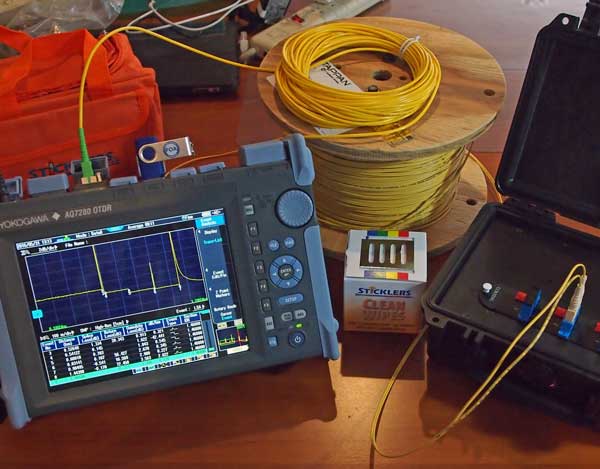Essential Features to Try To Find in Optical Fiber Screening Devices
When assessing optical fiber testing equipment, several important attributes necessitate mindful consideration to make sure optimal performance and reliability. Compatibility with existing sector standards enhances capability, while innovative measurement abilities, consisting of TDR and OTDR testing, deal essential insights into network integrity. Understanding these features will certainly lose light on exactly how to pick the right tools for your certain requirements.
Accuracy and Precision
Accuracy and precision are critical parameters in the assessment of optical fiber testing devices. These 2 characteristics ensure that measurements reflect truth performance of fiber optic systems, which is vital for efficient network installation, maintenance, and troubleshooting. Accuracy describes the closeness of a determined worth to the actual worth, while precision represents the repeatability of dimensions under unchanged conditions.
When choosing optical fiber testing devices, it is vital to take into consideration tools that supply high accuracy and accuracy to minimize mistakes in data analysis. Instruments such as optical time-domain reflectometers (OTDRs) and power meters must have calibration systems to guarantee regular efficiency over time. In addition, the specifications provided by makers should information the tools's dimension uncertainty, which directly influences the dependability of test outcomes.
Moreover, the efficiency of optical fiber screening devices can be affected by environmental elements, such as temperature level and moisture. As a result, selecting equipment designed to reduce these variables will certainly improve dimension integrity. In final thought, investing in optical fiber testing tools with robust accuracy and precision features is basic for preserving optimal network performance and ensuring the honesty of fibre optic communications.

User-Friendly User Interface
The effectiveness of optical fibre screening equipment is not entirely identified by its accuracy and accuracy; a straightforward interface plays a substantial role in enhancing operational efficiency. A properly designed user interface simplifies the communication in between the technician and the equipment, allowing for a much more intuitive understanding of complicated features.
Trick attributes of a straightforward interface consist of clear navigation menus, rational formats, and conveniently accessible controls. These aspects allow specialists to carry out tests quickly without substantial training, lowering the probability of customer mistake - ofda. Furthermore, visual signs such as progression bars, signals, and graphical representations of data can substantially improve the customer experience by providing instant responses on the testing process.
In addition, personalized setups can better simplify procedures by allowing customers to change criteria according to specific screening needs. This versatility not just saves time yet likewise makes sure that the tools meets varied application requirements.
Including assistance attributes, such as tooltips and detailed guidebooks, right into the interface can even more empower individuals, promoting self-sufficiency and confidence in operating the devices. Inevitably, an easy to use interface is essential for taking full advantage of the possibility of optical fibre screening devices, resulting in more efficient and effective screening results.
Portability and Longevity
Mobility and longevity are vital qualities of optical fiber screening devices, making sure that it this website can withstand the roughness of numerous environments while remaining simple to transport. Technicians commonly work in diverse settings, from telecoms hubs to remote setups, making it critical that testing tools are light-weight and compact (ofda). Devices made with transportability in mind typically features ergonomic handles and cases that help with effortless movement, thus improving functional effectiveness on-site
Longevity is similarly important, as optical fibre testing equipment is frequently subjected to severe conditions, consisting of temperature level fluctuations, moisture, and physical influences. Devices constructed with sturdy products such as strengthened plastics or steel real estates are better fit for these settings, reducing the threat of damage during use and transportation. Additionally, tools with water and dirt resistance ratings, such as IP scores, makes sure dependable efficiency in tough conditions.
Compatibility With Requirements
Ensuring compatibility with market requirements is crucial for optical fiber screening devices, as it directly impacts the integrity and legitimacy of test outcomes. Optical fibre networks go through strict efficiency standards developed by different organizations, including the Telecommunications Market Association (TIA) and the International Electrotechnical Payment (IEC) Testing tools must stick to these criteria to make sure that measurements correspond and equivalent across various systems and settings.
When picking optical fiber testing devices, individuals need to verify that the device meets appropriate requirements relevant to their particular application, such as those related to depletion, bandwidth, and crosstalk. Tools that is compliant with well-known standards not only assists in attaining precise click this outcomes however likewise assists in interoperability among gadgets from various manufacturers.
In addition, compatibility with criteria makes certain that the tools can be made use of in regulative conformity situations, which is vital for jobs in fields such as telecoms, aerospace, and armed read this forces applications. Consequently, buying optical fiber testing equipment that straightens with present industry criteria is an essential element of keeping high quality guarantee and achieving optimum network efficiency.
Advanced Measurement Abilities
Advanced measurement capacities are a specifying attribute of modern-day optical fiber testing tools, allowing for thorough evaluation of network performance. These capacities ensure that technicians can evaluate critical criteria such as signal loss, diffusion, and transmission capacity, which are crucial for preserving ideal communication performance.
One key facet is the capacity to perform time-domain reflectometry (TDR) and optical time-domain reflectometry (OTDR) examinations. These methods make it possible for customers to identify mistakes, measure the size of fibres, and determine the area of defects with remarkable precision - ofda. Furthermore, sophisticated equipment frequently consists of the capacity to gauge optical power degrees, helping to examine the overall health and wellness of the network and make certain conformity with the needed specs.
Furthermore, some screening tools use innovative formulas for real-time evaluation, allowing quicker medical diagnosis and troubleshooting. In verdict, spending in optical fiber screening tools with innovative dimension abilities is necessary for making sure network integrity and performance in today's demanding telecoms landscape.
Conclusion
